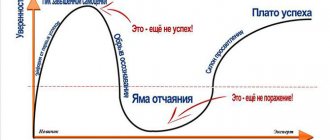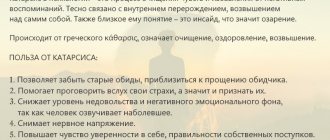In the modern world, especially in megacities, due to the need to work with large amounts of information, build relationships with many people, and lack of time for rest, a person certainly feels a lot of tension and stress. There are many ways to cope with stress. Today we will talk about a set of measures aimed at preventing the development or eliminating (complete or partial) stress conditions that have arisen under the influence of negative influences, the so-called distress.
In fact, in our everyday lives, we often intuitively use sets of techniques developed independently from our own experience that allow us to cope with anxiety, quickly get into a working rhythm, or relax and unwind as much as possible.
The methods of psychological self-regulation discussed in this article are based on a state of relaxation. Research results show that, while in this state, a person is able to accelerate the restructuring of certain biorhythms, quickly induce anesthesia in certain parts of the body, quickly fall asleep, improve the ability to concentrate, and ensure better mobilization of the body's resources.
So, there are different methods and modifications of psychological self-regulation techniques. Main classes of methods:
- neuromuscular relaxation;
- autogenic training;
- ideomotor training;
- sensory reproduction of images (method of figurative representations).
Problems that can be solved using psychological relaxation methods:
- Optimization of condition in order to ensure and maintain high performance for as long as possible.
- Eliminating the accumulating effects of fatigue during daily work.
- Relief of stress symptoms that disorganize activities and prevent them from performing normally.
- Relieving excessive emotional stress.
- Correction of chronic stress.
- Prevention of the occurrence of burnout syndrome or relief of its manifestations such as emotional exhaustion and a negative attitude towards people with whom a person comes into contact, for example, during work.
- Correction of neurotic conditions, increased levels of anxiety and fear.
Autogenic training
How to quickly restore strength?
How to relieve tension? How to quickly relax? All this can be done using a very powerful technique called autogenic training. A very important characteristic of this method is the absence of contraindications. Anyone can master this technique!
Unfortunately, people often learn about auto-training only at an appointment with a psychologist or at various trainings. But most successful people are familiar with the method and use auto-training for relaxation and self-tuning.
Autotraining is based on active self-hypnosis against the background of relaxation (muscle relaxation). Autotraining was first proposed in 1932 by the German doctor I. G. Schultz, although its elements were used earlier within the framework of meditative practices. Schultz showed that without any help from a hypnotist, people can enter states of rest, relaxation, partial and complete sleep, which are considered the first stages of hypnotic trance.
Autotraining I.G. Schultz is still the most reliable and effective method of psychotraining.
When creating auto-training I.G. Schultz relied on the work of Nikolai Bekhterev and the experience of Indian yoga. Autotraining is nothing more than a European version of yoga. We can also say that this is the very link that will help a European understand yoga.
What can you do with Autotraining?
We will use this technique for another very important purpose; to change negative attitudes. Read what negative attitudes are here.
Below I give you a simplified and shortened description of the technique.
Here's what you can do after mastering AT:
- Calm down, effectively relieve physical and mental stress. This is of great importance for the prevention of fatigue, neuroses and psychosomatic diseases.
- Take a quick rest. Restoring strength in an autogenic state is much faster than during sleep, simply lying down, watching TV or listening to music.
- Independently regulate body functions such as blood circulation, heart rate and breathing, blood supply to the brain, which is very important for the treatment of psychosomatic diseases.
- Fight the pain.
- Activate mental and physical functions, for example, attention, memory, imagination, ability to exercise.
- Activate creative resources through the development of intuition and imaginative thinking.
- Defeat bad habits by rationally combating stress, emotional and intellectual activation.
- Know yourself deeply. Ancient sages and doctors considered deep self-knowledge to be a condition for health and personal development.
Autogenic training in everyday life
For many people, it is easier to master autogenic training than to use it regularly in the future. This happens, as a rule, because it is difficult for us to refuse the temptation to solve our problems quickly and not to be discouraged by failures. Remember that there are no unsuccessful activities, any activity brings benefits. For example, you couldn’t concentrate on the introductory “Relaxation” exercise; “some nonsense was creeping into your head.” But notice that this “nonsense” distracted you from what was bothering you before the lesson, which you could not achieve in other ways. It doesn’t matter if you learn AT slower than others, because once you master it, you will gain a skill for life!
Try to organically “fit” autogenic training into your daily life. Remember that active reluctance to engage in AT occurs if there is no need for rest. “Catch” the moments when fatigue begins to accumulate, and the activity will be desirable. On the other hand, do not bring yourself to the point of overwork, when the activity becomes impossible due to deterioration in the ability to concentrate.
And, most importantly, remind yourself more often that the autogenic state is not something inaccessible, that it arises by itself in everyone who creates the conditions for its occurrence.
Basic poses for training
Autogenic training is divided into two levels - lower and higher
:
- At the lowest level, classes are conducted in one of three poses: lying down, reclining, and “coachman” pose. The key here is relaxation.
- At the highest level, visualization is practiced, similar to real hypnosis, and the posture here is not so important; however, basically the same poses are used as in the lower stage.
Dynamics of the autogenic state
When you engage in autogenic training, you passively focus your attention on calmness, the six standard exercises, and everything that happens to you. You should not try to change your condition in any way. Your body knows what state you need, and your passive position will allow the desired state to manifest itself. Two stages of the autogenic state can be distinguished:
- Passive stage. Calmness, relaxation, indifference to the environment increases, thinking slows down, while maintaining awareness of what is happening.
- Active stage. Awareness increases. The student acutely perceives and experiences what is happening to him. Logical thinking stops, perception of the environment is almost absent. Vivid experiences are possible: vivid visual images, suddenly formulated thoughts, liberation from the oppression of previously interfering experiences.
After leaving the active phase of the autogenic state, there is a surge of strength and a desire to realize the experiences that took place during the lesson. In this regard, exercises before bed should be short in order to prevent the transition to the active stage of the autogenic state - this can complicate the onset of sleep. After working out a little in the passive stage of the autogenic state, you should stop following the instructions and allow the autogenic state to go into sleep. As previously mentioned, exiting the autogenic state does not occur before bedtime.
The autogenic state differs from the drowsy state by the presence of constant awareness of everything that happens to us. Therefore, interaction with awareness allows you to regulate your state. By strengthening awareness, we remain in an autogenic state and prevent it from passing into dormancy. By allowing awareness to fade, we allow the autogenic state to pass into drowsiness and then into sleep.
In addition, the autogenic state can take shape in a number of levels (according to Oscar Ichazo, modified scheme):
- “Everything works out.” The initial state, in which the execution of instructions is interrupted by distractions from thoughts, extraneous sounds, etc., is replaced by a state in which the instructions are carried out easily and naturally. In this state, nothing can hinder the activity; everything helps it. For example, a sharp sound can respond with a wave of peace that fills the entire being of the practitioner. Marked heaviness of the body.
- "Bodily state." A blissful state arises in which the body is the source of bliss. For example, the light entering the eyes through lowered eyelids is perceived as extremely pleasant, gentle, and full of goodness. The feeling of heaviness of the body can be replaced by a feeling of lightness, weightlessness, and floating.
- "Point Consciousness" The body ceases to be perceived, “dissolves” and the practitioner realizes himself as a clot of consciousness.
- The disappearance of the boundary between the consciousness of the student and the surrounding world, the joyful experience of unity with it.
O. Ichazo’s scheme correlates with the previous scheme as follows: “Everything works out” and the version of the “bodily state” with the heaviness of the body is the passive stage, the remaining levels, starting with the “bodily state” with the lightness of the body, are the active phase.
Knowing the levels of the autogenic state allows you to be prepared to enter them and prevents a negative reaction associated with surprise. Even a single stay at levels 2–4 according to O. Ichazo is remembered for a long time and can be an incentive for further studies.
Autogenic meditation: the highest level of training
It is clear that the possibilities of autogenic training go far beyond the usual normalization of mental state and calm. This, one might say, is a special type of “yoga” that can even cure quite serious diseases - at least those that are of a psychosomatic nature. Various sources say that masters of “spiritual practices” acquired downright supernatural abilities over time. One can argue about how reliable such evidence is, but control over one’s own mental processes is definitely guaranteed. Of course, to achieve the highest meditative state it is necessary to train for more than a month or even a year, although there are cases when a person reaches the highest stage quickly and spontaneously.
Lower level exercises are aimed mainly at controlling the vegetative functions of the body. The highest level exercises developed by Schultz are necessary in order to learn how to evoke complex experiences, vivid visual images, achieve “autogenic neutralization” and catharsis - the highest spiritual purification. Using this technique, Schultz proposed to cure neurotic conditions. Of course, the possibilities of higher training are much wider.
Schultz considered the exercises of the lower level to be only a preparatory measure for the practice of the highest level, which he largely borrowed from Indian yogis. “Higher” exercises, according to Schultz, can only begin to be mastered when the “lower” exercises are fully mastered and all the necessary states are achieved in a maximum of thirty seconds. It is believed that the preparatory stage should last at least eight months. However, the practitioner begins to experience the first visual phenomena already when performing “lower” exercises - of course, not immediately.
An important skill for a practitioner is to learn to achieve the desired states during “lower” exercises in any environment, even in the presence of irritating factors.
Without this, you should not move to the highest stage.
:
- One of the first exercises
of the “higher” cycle is the recording of spontaneous color ideas. It is necessary to keep in mind the idea of a certain color that arose at the moment. After a few weeks of such training, the ability to first “see” randomly running colors appears, and then, among all this chaos, one color begins to dominate. - Another exercise
is to evoke in the mind certain ideas associated with a particular color. For example, golden, yellow, red evoke a feeling of warmth, blue - cold, black and dark purple - oppression and anxiety. - The third exercise
is calling specific objects into consciousness. At first these will be spontaneous images, and then - given objects. Schultz wrote that few people can achieve the ability to evoke clear images of objects; most imagine them only in a general form or in individual details. At the end of mastering the third exercise, the practitioner can “see” himself. - The fourth exercise
trains the ability to evoke images of abstract concepts such as “truth”, “justice”, “happiness” and others. These images may be specific objects, but they will always be strictly individual. Through these images, according to Schultz, the human subconscious expresses itself. - During the fifth exercise,
the trainee learns to imagine himself in certain situations. These images also arise spontaneously at first, and then purposefully. - During the sixth exercise,
the trainee learns to evoke images of other people. At first these are abstract human images and images of people who are indifferent to the trainee. Then people are called in who have some kind of relationship with the trainee and are either sympathetic or unpleasant to him. The second type of images is much more difficult to master, while the distinctive features of people are exaggerated, which is why, for example, unpleasant people appear in a somewhat caricatured form. Gradually, the images become more “calm”, the caricature features are neutralized, and the trainee becomes indifferent to these people. - The seventh exercise
is the final and most important. At this stage, the trainee asks himself important questions - “Who am I?”, “What do I want?” and others, and the subconscious gives the answer - in the form of a stream of images, during which you can see yourself as if from the outside. At this moment, that same spiritual cleansing occurs - catharsis, “autogenic neutralization” occurs, during which the trainee is healed.
It is curious that Schulz considered the exercises of the highest level to be the most important and basic in the entire complex, but they did not find wide application or great popularity; on the other hand, exercises of the lower level, to which Schultz did not attach much value and considered them only preparation for the main exercises, received mass recognition.
Autogenous modification
Autogenic modification is a change in one’s state and behavior in an autogenic state. Before you engage in autogenic modification, you should make a list of tasks that you want to solve using autogenic training and distribute them according to the degree of difficulty for you. Start with the easiest one.
Describe the picture of the condition that prevents you from achieving your goal. Pay attention to its emotional, intellectual (mental) and bodily components. For example, timidity, accompanied by tension, a feeling of chill along the spine and thoughts like: “That’s it! I won’t give up!” Create a complex positive image that is the opposite of the above. In this case, the image could be like this: calm, warmth along the spine and the thought:
"I'm confident in myself"
or shorter:
"Sure".
It is also good to analyze your state in those cases when you managed to overcome this difficulty, and supplement it with elements of a complex positive image. Self-hypnosis formulas must meet the following requirements:
- Brevity. We do not think in long, detailed sentences, so a short phrase will be better imprinted on our consciousness. For example, the formula: “I am calm” is better than “I am calm and confident in all situations.”
- Positivity. The formula should affirm, not deny. For example, the formula: “I am not afraid of exams” can increase fear. The following formulas should be used: “I’m sure”, “I remember everything”, etc.
- Individuality. The formula is made just for you, it does not have to satisfy everyone. Remember how in difficult moments a phrase that only you understood helped you. If, for example, the word “That’s it!” has helped you before. in overcoming the craving for smoking, you can safely use it for autogenic modification, although it may seem pointless to another person.
Exercise
Make a table. In the first column, place the tasks facing you, starting with the simplest and ending with the most complex. In the second column, write down the conditions that prevent you from achieving each goal. In the third column, place a comprehensive positive image for each situation. In an autogenic state, together with the six standard exercises, contemplate a complex positive image of the easiest task. After achieving the first task, you can move on to the next one.
Remove the pain
The fight against pain is carried out in a similar way. A complex positive image includes coolness or warmth in the area that needs to be numbed (to be specified by the doctor) and formulas about insensitivity, foreignness or absence of this area. For example, a complex positive image for tooth extraction: calmness, a huge relaxing heaviness in the whole body, coldness in the lower half of the face, as if you were lying face down in the snow, and as a result of this the lower part of the face has become insensitive, the formula: “The lower part of the face is alien” or simply “Alien” when directing attention to the lower part of the face.
Fear of situations
If a certain situation causes you difficulties, for example, fear of riding in public transport, fear of heights, fear of public speaking, you can use contemplation of these situations against the background of an autogenic state. Systematically combining the image of this situation with calmness will lead to the fact that in the real situation you will feel calm. This method, called systematic desensitization by Joseph Walp (USA), can be combined with the use of complex positive imagery.
Neuromuscular relaxation technique
- is a course of systematic training on voluntary relaxation of various groups of striated muscles.
Each exercise consists of alternating periods of maximum contraction and quickly followed by relaxation of a certain area of the body (“worked” in a certain sequence: muscles of the limbs (legs, arms), torso, shoulders, neck, head, face). During the process of relaxation, a person feels a sensation of softening, the spread of a wave of heat and pleasant heaviness in the area of the body being worked, a feeling of peace and relaxation. This indicates the elimination of residual usually unnoticed tension in the muscles, increased blood flow to the vessels of the area being worked on, and increased metabolic and recovery processes.
It is important that muscle relaxation causes psychological relaxation.
A person who has perfectly mastered the technique is able to voluntarily induce relaxation in those life situations when it is necessary to quickly relieve or reduce the degree of acute experiences and overstrain.
Research shows that the use of neuromuscular relaxation techniques is effective for insomnia, hypertension, migraines, and neurotic conditions.
You can get acquainted with the text of the neuromuscular relaxation session in the book “Psychological technologies for managing the human condition” by Leonova A.B., Kuznetsova A.S.
What is the best way to get out of an autogenic state?
A special exit technique allows you to effectively move from an autogenic state to wakefulness in a short time and become as active as possible.
To exit the autogenic state:
- stop following the instructions of the lesson and concentrate on the fact that you are well rested and will soon leave the autogenic state;
- slowly clench your fists, feel the strength in your hands, throughout your body; Otherwise, do not change the position;
- Without unclenching your fists, extend your arms towards your knees;
- wait until the end of the next exhalation;
- take a deep breath, while inhaling, raise your arms up, arch your back, turn your face up;
- pause for about 1-2 seconds to prepare for the precise execution of the last exit phase;
- at the same time: exhale sharply through your mouth, unclench your fists and open your eyes. After this, calmly lower your hands (see Fig. 2).
When exiting the autogenic state, you should focus as much as possible on the energy and strength accumulated during the lesson (even if their increase was small). Move on to each exit phase only after the previous one has been completed.
For those whose blood pressure tends to rise, when exiting, you need to concentrate on the calm, peaceful strength that has accumulated during the session. Those prone to low blood pressure should focus on being cheerful, energized, feeling a chill along the spine, and “goosebumps” running along the body. Do not use the described technique 1–1.5 hours before bedtime. After finishing the lesson, stop following the instructions for this lesson, sit for a while with your eyes closed, then slowly straighten your back and open your eyes. Sit for 1-2 minutes, after which you can get up.
Practical development of methods for effectively exiting the autogenic state is of great importance. Insufficiently precise implementation of it leads to lethargy and weakness after AT classes. This reduces the value of the classes and may cause them to stop. On the contrary, even the isolated use of this technique without a previous AT session can cause cheerfulness, a surge of strength, and an increase in performance.
The most common mistakes: speed and crumpled execution, lack of pauses between phases, not opening the eyes at the same time, exhaling, unclenching the fists in the phase, insufficiently sharp exhalation.
Mastering auto-training is the beginning of a new page in your life. It should become a part of your existence from now on. You gain the ability to manage yourself, restore your strength, and regulate your performance.
Author: Petrov Nikolay Alexandrovich Book: Autogenic training for you
Maxim Vasilchenko, graphologist
results
Main results of the study
According to the data obtained (see table),
Dynamics of psychological test scores for 1 month in patients of the main and control groups (DM±m) Note. * — p<0.05; ** — p<0.01; *** — p<0.001. in the main group by the end of the observation there was a significantly more pronounced decrease in indicators on scales 1, 2 and 7 and an increase in values on the 9th scale of the SMOL test, which indicates a decrease in the level of anxiety, tension, fixation of attention on one’s own sensations, increased activity and mood against the background of AT.
In the main group, a significantly more pronounced ( p
<0.001) compared to the control, a decrease in the level of reactive and personal anxiety according to the ShTT and a decrease in indicators according to the BDS.
The study of the mechanisms of action of AT revealed the following correlations: changes in indicators on the ShTT and the 2nd SMOT scale correlated with the dynamics of systolic blood pressure in patients with hypertension ( r
=0.51,
p
<0.001 and
r
=0.46,
p
<0.01, respectively);
dynamics of indicators on the ShTT, ShDB, 2nd and 9th SMOL scales - with the severity of pain according to the visual analog pain scale in patients with chronic nonspecific salpingo-oophoritis ( r
=0.54,
p
<0.001;
r
=0.44
p
<0.01;
r
=0.55,
p
<0.001 and
r
=–0.45,
p
<0.01, respectively), spinal osteochondrosis (
r
=0.50,
p
<0.001;
r
=0.42,
p
<0.01;
r
=0.48,
p
<0.01 and
r
=–0.41,
p
<0.01, respectively) and irritable bowel syndrome (
r
=0.57,
p
<0.001;
r
=0. 39,
p
<0.05;
r
=0.48,
p
<0.01 and
r
=–0.38,
p
<0.05, respectively).
Analysis of predictors of the effectiveness of AT revealed in the subgroup with an improvement in the psychological state significantly higher background (before treatment) indicators for the 4th (62.1 ± 1.58 and 47.2 ± 0.96 T) than in the subgroup with its normalization -score accordingly; p
<0.001) and 6th (61.3±1.97 and 50.1±0.87 T-scores, respectively;
p
<0.01) SMOL scales.
BDS scores above 20 points (indicating the presence of a moderate or severe degree of depression) before treatment were detected in 11 (31%) patients in subgroup B, and only 2 (1.6%) patients in subgroup A (χ2 = 29, 5; p
<0.01).
Additional Study Findings
Analysis of the effectiveness of AT depending on the nature of the underlying pathological process did not reveal significant differences in the dynamics of psychological status in patients with various chronic diseases.
Adverse events
There were no adverse events.











